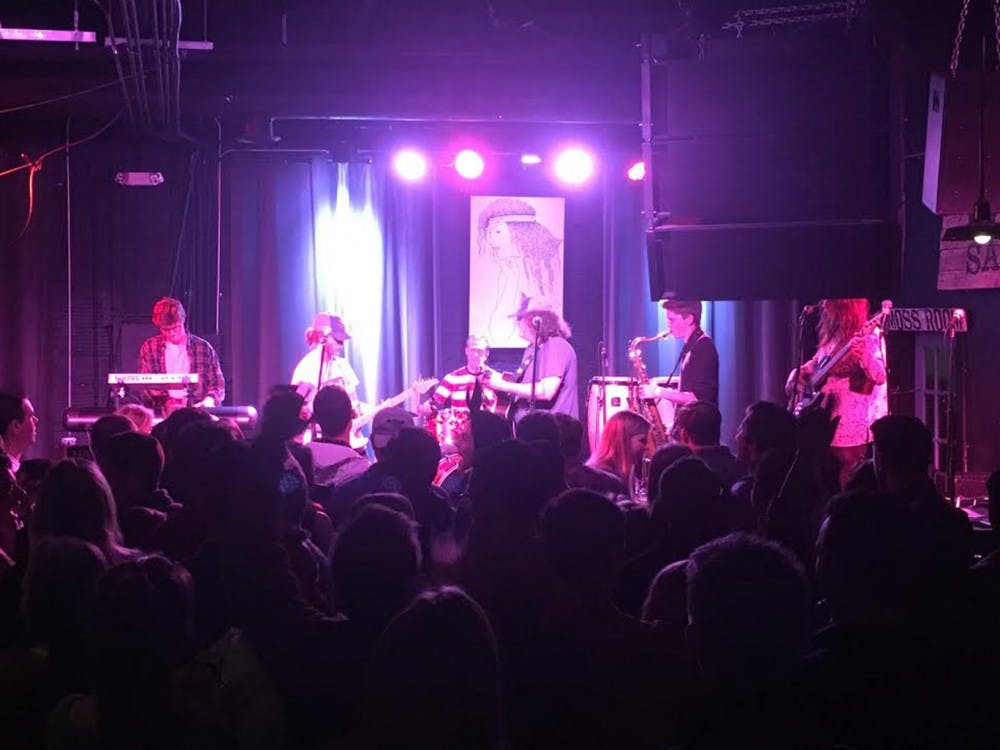They say that people are always in good company when they are doing what they truly enjoy with the folks who they truly enjoy. Whether it’s with friends, family or strangers, good company encourages you to bounce thoughts off of each other and turn those thoughts into reality. Good company leads to good inspiration.
For the last five years, there has been no better company at the University than the six young men of Kendall Street Company. They hardly need an introduction — KSC has become a household name in the University community. Whether it’s a Saturday afternoon over by Mad Bowl or a Friday night at The Jefferson, a time spent with these guys is time well-spent.
Wanting to know more about the personalities behind the tunes, I set out to meet the band. It wasn’t very hard — they live about two minutes from me. I met them outside a coffee shop with no place to sit inside and the looming prospects of Hurricane Florence outside. We thought Florence was an easier bet.
From my left to right was lead guitarist Ben Laderberg, saxophonist and current third-year College student Jake Vanaman, bass guitarist Brian Roy and frontman Louis Smith. All four of them brought unique personalities and experiences that flowed together and enhanced their ability to finish each other’s thoughts. Smith, whose looks reflect his humor, laughed off every question I asked like I was taking this way too seriously.
“The first [goal] was to get a gig at Durty Nelly’s,” Smith said, referencing a Charlottesville pub and deli. He also said they wanted to get a sandwich while they were at it. “We got a sandwich at Durty Nelly’s. It was a damn good sandwich.”
Roy described how difficult the transition from local shows to national relevance can be.
“We now know that we can take this outside of Charlottesville and do really well,” he said. “Then we’ll go to other places and there’ll be four people at the show. We played some shows on the summer tour and there were single digit numbers of people there.”
This made the guys crack up. They all managed to have a positive spin on the memory of playing a show that nobody showed up to. Maybe it’s something they can now look back on and laugh about, but isn’t that what young bands need to do? Pay your dues. How can you appreciate success when you’ve never endured humility?
Roy had a lot to say on the subject.
“You just have to keep yourself going,” he explained. “If you’re playing for a crowd that’s really small, you just want to play for yourselves and have fun. If the crowd is really big, it’s just as important to play for ourselves and have fun with it. It doesn’t make too much of a difference whether there’s more or less people. You do breathe a lot of energy from the crowd, but you breathe even more from yourself.”
How very Jerry Garcia of Roy to say that there isn’t much more to playing music than having fun — some would go so far as to say there isn’t much more to life than having fun. Roy clearly has a lot of fun. That afternoon, the fashionista who regularly wears a plentiful configuration of dashikis on stage donned a staggering green blazer with so many blended colors and swirls that created quite the visually stimulating composition. I found myself completely lost in it.
In a fun moment of irony, Roy described his interaction with their crowds the same way I was looking at his jacket.
“If the energy is really high, I like to see people, but I get distracted by the crowd,” he said. “I’ll see someone and be like, ‘That’s a cool shirt.’ And then all of a sudden I’m missing a note.”
Laderberg, on the other hand, loves looking deep into his audiences.
“I like to find one person in the audience and play off them,” he said. “Just lock eyes, all creepily, for the whole show and feed off them.”
Being awfully young and not nearly having their adult lives figured out, KSC is way ahead of the curve for in terms of success. Having achieved fame — albeit a small proportion to what they’re bound to appreciate — bands tend to seek out representation. For the time being, Kendall Street is pursuing a different but equally successful route.
“We run it like a business, so there’s no point not to consider an offer if we were to get one,” said Roy. “In the past, you needed a label to put your stuff out there. Now you just need the internet. It’s easier to get your music out there with Spotify and iTunes and internet radio stations.”
Plenty of modern bands and artists are taking this innovative approach to making music as a career. By no means is there a clear and concise map to success in the music business.
“We aren’t hiding our music,” Roy continued. “You can listen to it for free on the internet. You can go to our website and listen to it … We have live recordings online that can be listened to and downloaded for free. So when someone comes to a show and buys a CD for $10, it’s them saying, ‘I appreciate what you do and want to support it,’ and that helps us keep gas in the van. We love those people.”
Unmistakably, the guys are ambitious about getting their music in front of listeners to appreciate, whether or not they make a lot of money from it. But where does that music come from? What is it about creative processes that makes them eager to make more?
Laderberg had a response locked and loaded.
“The most concise form I can think of is an outlet to express the ups and downs of life that fills all of our experiences,” he said. “We’re more metaphorical than literal.” A collective, “whoa, that was deep” came from his friends.
Vanaman chimed in that their music is “individual and communal. We spend a lot of time together. Every time I get in that van, I know I’m going to see something I’ve never seen before.”
“A lot of our songs can be pretty silly,” Roy said. “Because we’re silly people, and when you hang out with each other all the time, you just make funny jokes that aren’t even that funny — but they’re funny to us.”
Laughing his buddy’s answer off like usual, Smith added, “And then those jokes find their way into songs.”
Next time you see the guys on the steps of a fraternity party or on stage in New York, look for the psyche behind the instruments. Think of the individuality and the camaraderie. Try to lock eyes with Laderberg while he’s shredding his guitar solos. Look at Smith not taking himself too seriously. You may be a stranger in the crowd, but you’re already a friend to the music. Give a child a toy and he’ll tear up while playing. Give him a companion, and he’ll give you art.







